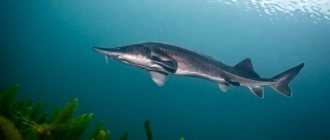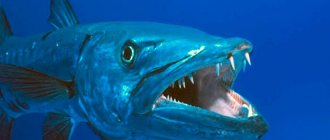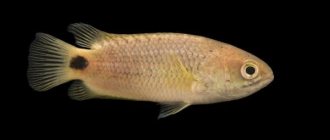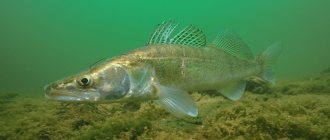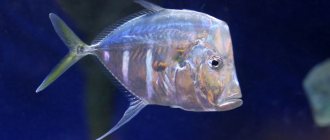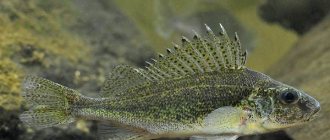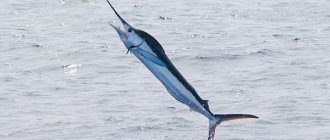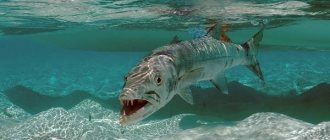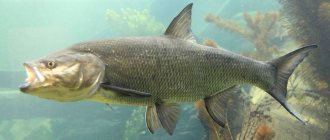Pike is the most famous and popular predator fish living in freshwater bodies of Eurasia and North America. Pike leads a solitary lifestyle, living in the coastal zone, in thickets of aquatic plants in rivers and lakes. Pike belongs to the pike family, the genus pike. The genus Pike includes five species of fish, three of which (Redfin pike, Black pike, Muskiong pike) are found only in North America and two species, Common pike and Amur pike, are found in our country. Pike is a very popular fish among anglers, especially among spinning anglers.
What does a pike look like?
Pike is considered the most voracious predator of the country's water bodies. She leads a secretive, sedentary lifestyle. Tends to hunt prey at close range from an ambush, guarding future food while in cover. But during the period of active feeding, the fish changes tactics, moves around its grounds, and when it sees a target, it attacks and aggressively pursues it.
The structure of fish and its features
It is easy to recognize a pike: it has an elongated body, almost cylindrical in shape. Due to this structure and the presence of single fins attached to the tail, the fish is capable of developing lightning speed.
The plumage is well developed, characterized by a paddle-shaped or rounded shape, which also has a positive effect on the hydrodynamics of the pike. The scales fit tightly to each other, forming a dense monolithic cover throughout the body - this helps protect the fish from the sharp teeth of predators or relatives.
Mouth, vision and sense organs
The fish has a flattened, wedge-shaped snout, which allows the pike to see frontally - this helps it assess the speed of moving fish and the distance to them. This structural feature of the skull and high-set eyes give the pike the opportunity to view the water area not only above it, but also from the side, and also see objects below it.
But due to the wide open mouth, the angle of view below itself is significantly reduced, which does not allow the fish to see the target up close if it is below it. Anglers who are aware of this feature try not to push their baits to the bottom.
The predator has excellent hearing, thanks to which it is able to go hunting even in muddy water, picking up the source of the slightest vibrations in the water from a great distance. Pike has a wide and elongated snout, which has a significant gripping area, and the peculiarity of the structure of the gill membranes, separated from each other, does not make it difficult for the fish to open its mouth wide to catch large fish.
Teeth and their replacement
In the mouth of the predator there is a huge number of sharp teeth, some of which are located on the jaws and consist of fangs of different sizes. On the tongue and palate, bristle teeth are visible, which represent a fleecy cover of needle-like formations, reminiscent of the bristles of toothbrushes.
Interestingly, the pike does not chew its prey with its teeth; it needs them to hold onto it. The main weapon of a fish is its teeth, because with them it can cause serious injuries to inexperienced fishermen who do not know how to handle it.
Another feature of the fish is the replacement of old and damaged teeth. Some believe that this happens after spawning on a full moon. The change of teeth in pikes is not periodic, but constant. When changing teeth, the fish continues to feed, which means it can be successfully caught. The absence of a bite immediately after spawning indicates a loss of strength in the exhausted fish after reproduction, but not a change in teeth.
Color
Pike is distinguished by its camouflage color, which allows it to remain unnoticed anywhere in the reservoir. The fish has light transverse stripes and spots in the form of a camouflage pattern throughout almost the entire body, except for the belly. This is especially good for fish in places where there is a lot of dense vegetation and snags.
It is very difficult to accurately answer which color is considered to be background and which belongs to the picture. The tone depends on the age of the fish, habitat, nutrition and other factors. Juveniles have a lighter coloration, which becomes darker as the fish matures. The most common color, characteristic of many fish, is gray-green with olive stripes and spots. Usually the fish has a dark back, a light yellow or gray-white belly with gray specks, and gray fins with light streaks and stripes.
Varieties of pike
Pike is a large fish, numbering seven varieties. These include common, American, Amur, black, southern, Aquitanian pike and musky fish.
Ordinary
A typical representative of the genus. Inhabits many freshwater bodies of Eurasian and North American countries. The body length reaches 1.5 meters with an average weight of 8 kilograms. The color of the common pike varies depending on its habitat. There are gray-green specimens, individuals with a brown color and gray-yellowish fish.
The common pike prefers to settle in thickets, stagnant waters, and the coastal part of the reservoir.
American
This is a redfin pike that lives only in eastern North America. It is divided into two subspecies: the northern redfin pike and the southern redfin pike, found in the Mississippi and waterways flowing into the Atlantic Ocean.
Not a single subspecies of American pike is large in size. They grow up to 35-40 centimeters in length and reach a weight of 1 kilogram. A distinctive feature is the shortened snout. Southern pike do not have red fins. The lifespan of American pike is no more than 10 years.
Muskinong
The largest species of pike, considered a rare species. The fish was given its name by the Indians, who called it maashkinoozhe, which means “ugly pike.” The fish received its second name “giant pike” due to its impressive size. Some individuals can reach a weight of up to 32 kilograms with a body length of up to 1.8 meters. A distinctive feature of pike is its silver, green or brownish-brown body color. There are spots or vertical stripes on the back.
Amurskaya
Fish with small silvery or golden-greenish scales. The color of the Amur pike is interesting - numerous black-brown spots are scattered throughout the body, from head to tail.
Representatives of this species grow up to 1.15 meters, reaching a weight of up to 20 kilograms. The Amur pike lives in the reservoirs of Sakhalin Island and in the Amur River. Life expectancy is up to 14 years.
South
Previously, the southern pike was considered a subspecies of the common pike. The species was first identified in 2011. The fish lives in the reservoirs of Central and Northern Italy.
Black
A predator that lives in North America, inhabiting lakes and overgrown rivers from the southern shores of Canada to the state of Florida in the USA and further to the Great Lakes and Mississippi valleys. The body length of adult individuals reaches up to 60 centimeters and weighs 2 kilograms. Externally, black pike is similar to the common species. A characteristic difference is a mosaic pattern on the sides and a dark stripe above the eyes.
Aquitaine
A young species that was first described in 2014. The habitat of the Aquitaine pike is France, where the fish inhabits almost all bodies of water.
Where does the predator live?
Pike inhabits fresh water bodies of North America and Eurasia. Usually the fish hides in low-flowing or stagnant waters, coastal areas, and thickets. The fish leads a sedentary life in lakes, rivers, and ponds. But pike are often found in partially desalinated areas of the seas, for example, in the Curonian, Finnish and Riga bays of the Baltic Sea.
In lakes and ponds, the predator swims close to the shore, remaining in littered shallow water with thickets of algae. In rivers, fish are found not only near the coast, but also at depth. It is preferable for pike to live in the mouths of rivers flowing into large reservoirs.
Pike feels comfortable in those reservoirs where there is sufficient oxygen content, because even with a winter drop in the water level, the predator can die. The fish tolerates acidified water very well, which is why it is often found even in swamps. The fish tries to avoid fast and rocky rivers.
The main condition for the presence of fish is the presence of abundant vegetation. In the northern regions, fish often hide behind stones, under bushes or snags - there they wait for their prey.
In an ambush, the fish remains motionless, after which it rushes sharply and quickly towards its target. It is rarely possible to cope with the death grip of a pike; if it chases prey, it will not be possible to escape. The peculiarity of this fish is the ability to make high jumps in the air, and it is also capable of swallowing a victim only from the head.
Summer features
In summer, pike change their habits. It can be passive in the heat, but increases activity as the temperature drops. For successful fishing, you need to be able to predict its behavior. The choice of bait depends on this.
If the fish goes deep, it is almost impossible to catch it. However, in shallow water there is a chance to get hold of small fish.You need to look for it near water snags, in accumulations of algae, at the boundaries of depressions. You can use both natural and artificial baits, and best of all, combined ones.
What do fish eat?
Pike fry prefer microorganisms that are in the water. But as the fish grows, it begins to feast on the fry of smaller fish. The diet of adults consists exclusively of fish. The most attractive to predators are small live fish, including crucian carp, roach, bleak, rudd, perch and fish of the carp family. Fears unfamiliar fish.
Pike eat 3-4 times a year, usually before spawning, after spawning, in May-July, and in September-October.
These dates are considered conditional, because a lot depends on weather conditions.
From the Grefirn River, 25 kg
On October 16, 1986, a significant event occurred - a huge fish was caught in the Gräfirn river, which is located in Germany. Previously, a little-known lake became famous throughout the world, and Lothar Louis’s catch is still remembered, because he owns a trophy of serious size - a pike weighing 25 kg. The day of October 16 was cold, the mood was most likely neutral, and nothing foreshadowed such a significant catch. At that time, this catch was the largest, so representatives of the Guinness Book hastened to record it.
Spawning and offspring
Pike spawn at a temperature of 3-6 degrees, immediately after the ice begins to melt, at a depth of 15 to 1000 meters (depending on the area). During spawning, pike swims into shallow water and splashes noisily. In natural reservoirs, males reach puberty at 4 years of age, females at 5 years of age.
Typically, reproduction begins with the smallest individuals, after which it is time for the larger individuals to spawn. At this time, pikes stay in groups, 2-4 males per female, and up to 8 males among large females. The female pike swims in front for spawning, followed by the males on the side. During the breeding season, fish begin to rub against bushes, stumps, reed stems, cattails and other objects. The fish do not stay in one place for a long time, they constantly move around the spawning area, spawning.
If after breeding the water quickly subsides, mass death of eggs occurs. This phenomenon often occurs during spring drawdown (reset) of the level in reservoirs.
Reaching a length of 12-15 millimeters, pike fry are already capable of independently hunting for the larvae of carp fish. Typically, fish of the carp family spawn after pikes, thanks to which pike juveniles manage to become significantly satiated. After individuals reach a size of 5 centimeters, they completely switch to feeding on the young of other fish.
In the spring, pike, along with flood waters, settle in floodplain lakes. After some time, the connection between lakes and rivers is interrupted, which is why the lifestyle of such pike differs significantly from the life of relatives living in rivers or large reservoirs. Lack of nutrition leads to the fact that individuals of the same age can be 2-2.5 times smaller in size. Small fish become prey for larger predators.
Predator or not
It’s not for nothing that pike is called the river robber. Nature has made fish a real killer. From the earliest months, the 10mm pike fry show their predatory nature. Even at the development stage, it feeds on carp and stickleback larvae, while other fish fry eat zooplankton.
Pike is a lonely water wolf! She swims and lives alone or with a small group of comparable individuals, since large fish eat their smaller brothers without regret. Some people think that during a change in dentition, the pike stops hunting and starves until the dentition is completely restored. This is wrong! A predator's teeth change gradually, so the temporary loss of several teeth cannot in any way affect its appetite level. There are cases when, due to a lack of minerals in the body, changing teeth is more painful for the pike. Only then does she have to face certain restrictions related to the size of the food consumed.
Pike fishing
Pike fishing is a varied activity where various baits and methods are successfully used. When pike are caught with a spinning rod from the shore or from a spit, spoons, mainly spinners, are often used.
Seasonality
Every fisherman knows that pike is a solitary fish that prefers bodies of water with weak currents; it lives near vegetation and settles in holes and snags. From the first days, pike fry begin to actively hunt. By the end of the first year of life, the young reach up to 40 centimeters in length and weigh up to 1 kilogram.
In large lakes, about several dozen individuals are caught in one season; their length is up to 1 meter and their weight is up to 15 kilograms. The best time to fish is in spring and fall.
In spring , pike begin to reproduce. During this period, its fishing is prohibited. After spawning, she begins to eat, which helps to restore strength. The fish, hungry during the winter, rush at everything that comes into their field of vision and take any bait. In spring, pike usually bite during daylight hours; at night, the fish sleep. Shallows and coastal vegetation are considered fishing spots. Fishermen achieve especially good results on warm, cloudy days.
In the autumn , when the “hungry” months are approaching, the fish begins to stock up on fat. In autumn, the bite is not so intense, and the pike stays at the depth where small fish go for the winter, but the fishing is much more interesting, especially since during the summer the pike gain weight, are energetic and active in resistance. The meat of such fish is considered very tasty.
In summer , pike bite inconsistently, and if they take the bait, it is extremely unreliable, and often clings only with the lower lip at the very edge and often comes off the hook. The best time for fishing is the beginning of noon and until 16:00 in the evening.
In summer, predators move to thickets of water lilies, lotus and water chestnut, due to the fact that there are many small fish and duck broods. During this period, huge pikes weighing 10-15 kilograms are visible almost in the shallows. If you throw a spoon or wobbler correctly, you will be able to catch a large specimen.
Spinning fishing
It is good to use both oscillating and spinning spoons for pike fishing. But the fisherman needs to know that spinning ones sink more slowly and are preferable to use in fast currents and in the grass.
Wobblers are synthetic fish that imitate the behavior of fry. They are divided into floating and sinking. Swimming fish are used to catch pike in the upper layers of water - no more than 2 meters; sinking fish are quickly lowered to depth. The optimal size of a wobbler is considered to be 7-12 centimeters. It is permissible to take 4-6 centimeters, but then the likelihood of catching a trophy specimen is significantly reduced.
Fishing
Pike are caught using a landing net or hook. If you manage to catch the first pike and do not have these devices at hand, you should not grab the prey with your hands - the pike will not only escape, but also injure your hands.
The most reliable way to fish a pike out of the water with your bare hands is to bring the fish to the shore, press on the eyes of the pike with your thumb and forefinger, and calmly pull the fish out of the water. You can avoid injury only by removing the bait from the fish’s mouth using an extractor. They open the mouth of the pike with a gaper.
How to catch a trophy pike?
Big fishing requires careful preparation and adjustment. First of all, big pike like big bait. Silicone monsters up to 25 centimeters long are considered more successful baits for catching fish. Small fish will not swim up to such a “monster,” but individuals weighing 7-8 kilograms will definitely attack. They catch trophy pike on a motor boat, dragging several baits behind them, at a slow speed.
A peculiarity of predatory fish is that after an unsuccessful hooking, the fish will not hide in the depths and will not swim far; on the contrary, it will return to its stopping place. Due to this, it is necessary to repeatedly fish potential places where pike can sit in ambush. It is important to know that pike will never go on a long chase, but from 10 meters it can take risks. Fishermen noted that sometimes the pike jumped out of the water in an attempt to catch the departing bait.
From Sortavala, 49 kg
Large catches went to fishermen from Russia. Fishermen hunted on the lakes near Sortavala (an ancient town in Karelia, with a population of less than 200,000 people). Unexpectedly for them, a large pike weighing 49 kg pecked on the hook, and quite by accident. The fishermen tried to pull another fish out of the water, but they were very lucky. The situation turned out to be quite funny: a large pike wanted to eat and took fish from the fishermen. It turned out that the caught fish became bait for a large pike.
Useful properties of pike
The main advantage of pike is that it has dietary properties due to its low calorie content and minimal fat content. Pike meat is also rich in powerful natural antiseptics, which not only strengthen the immune system, but also help resist bacterial infections. Because of this, consumption of pike meat is recommended for the prevention of influenza.
Pike contains phosphorus and potassium, B vitamins and other substances - its regular consumption helps reduce the risk of heart arrhythmia. Pike is very useful for people who have cardiovascular diseases, problems with the gastrointestinal tract, obesity, and hypovitaminosis.
In cooking
Pike meat has the most pronounced marine taste. Fish flesh is snow-white and slightly fibrous, so you need to cook it carefully.
Yandex pictures
Meat can be prepared in a variety of ways:
- Fry portioned steaks in oil with lemon juice and green onions.
- Cook a rich fish soup from the head and tail of the fish.
- Stuff a whole bone carcass with vegetables and cook it in the oven.
- Stew pieces of meat with cabbage, carrots, onions and tomato sauce.
The fish has white, flaky flesh with a rather watery taste. The white flesh is rich in protein and good in healthy fats.
Remember, the flesh of fish is easy to overheat, so its meat can turn out very dry. The main thing to be careful about when eating pike is the bones. The pike carcass contains smaller, sharp bones that are difficult to detect with the naked eye. Even crucian carp is not so bony!
Properly salted golden pike caviar is not inferior to black sturgeon caviar in its beneficial properties and taste characteristics. Its composition is famous for its high content of phosphorus, iodine and iron. The taste of the delicacy is especially delicate! The possibilities for preparing this fish are limited only by your imagination. Try to taste a dish made from this fish at least once!
Do they breed and raise pike?
Pike is a predatory fish, and for this reason it should not be bred in ponds where carp or trout are raised. But fish perform well in natural lakes, ponds and rivers, where there are a lot of trash fish, which will be the basis of the diet.
Many entrepreneurs are engaged in successful breeding of pike in lakes with shores abundantly overgrown with vegetation. In such places there are always a lot of small fish, and here it will be easy for pike to catch prey. But in reservoirs with poor vegetation, where there are few forage fish, one cannot dream of successfully breeding pike, because from hunger it is prone to eating small relatives.
When artificially bred, pike are able to gain weight much faster than in natural conditions. If there is an abundance of forage fish, pike fingerlings weigh on average about 400 grams, and individual specimens sometimes weigh up to 1 kilogram.
Features of growing fish:
- Breeding fingerlings are raised in feeding ponds along with carp. The next year, most fish farmers keep only replacement young stock, and the rest of the stock is sent for sale. Fish that are 2 years old are raised in carp brood ponds, where they will feed on carp fry and weed crucian carp. In winter, pikes are sent to earthen cages, where 15-20 fingerlings of crucian carp or roach are planted with them per 1 pike.
- If a fishery does not have its own broodstock, pike from natural reservoirs are used to obtain young stock. Due to physiological characteristics, at least five males are taken per female. Earthen cages or small ponds where there is abundant bottom vegetation are suitable for breeding - spawning is possible only on this.
- Already on the third day, pike larvae are caught from the cages. No later than 15 days after hatching, the larvae are sent to feeding reservoirs, where they will be able to find food for themselves. To ensure that the larvae do not remain on underwater vegetation during the process of being caught from the spawning ground, it is first removed.
Raising pike in ponds is a troublesome task; it is preferable to use special devices in which the eggs are inseminated and the further artificial incubation process takes place.
In feeding reservoirs, the survival rate of young animals is on average about 50%. For one hectare of pond where there is a lot of weed fish, there are no more than 400 pike individuals, where there are few of them - no more than 250. But where there are no weed fish at all, up to 120 fry are released. In large reservoirs there are 300 pike fry per 1 hectare of water surface. In this case, reservoirs must be drained once every 2 years.
Interesting Facts
The largest pike that was ever caught is the fish that Emperor Frederick II Barbaross personally caught in 1230 in the city of Helboron. At that time, the length of the fish was slightly less than 3 meters, and its weight reached more than 70 kilograms. The fish were ringed and released back into the lake. After 267 years, this fish was caught in the same lake, but its length had already reached 5.7 meters and its weight was 140 kilograms. Due to its long life, the pike acquired a completely white color. The fish was released again, but no one else saw it.
Another interesting fact is that over the course of a long life, fish gain experience, grow, and look for larger prey. They are able to feast on small ducks, muskrats and other waterfowl. Individuals reaching a length of more than 2 meters can also feed on larger mammals, for example, dogs, or when reaching a length of 5 meters, attack a person (such cases are unknown, but quite real).
Pike is a large predatory fish that can be bred in your own pond. They make quite a good profit from retail sales, because fish meat is highly valued due to its rich composition, low calorie content, and beneficial effects on the human body.
0
0
Copy link
From the Osthammer River, 17 kg
Fishing is a fascinating activity, and sometimes it even brings surprises. In Lake Osthammer in Switzerland, a man named Benny Petterson caught a large fish, although his silver spoon was intended for smaller catches. The fishing turned out to be successful - Benny pulled out a 17 kg pike from the river. “But how will I get her home?” – the man thought at that moment, because he had a small boat with him, or more precisely, a single-seater boat. But the fish was raised after 10 minutes and, as a result, was listed in the Guinness Book.
